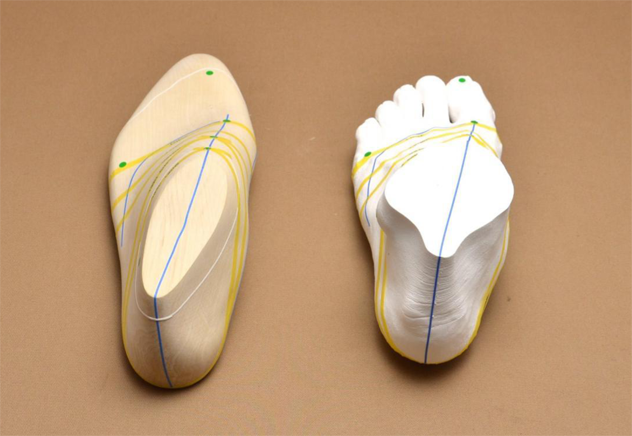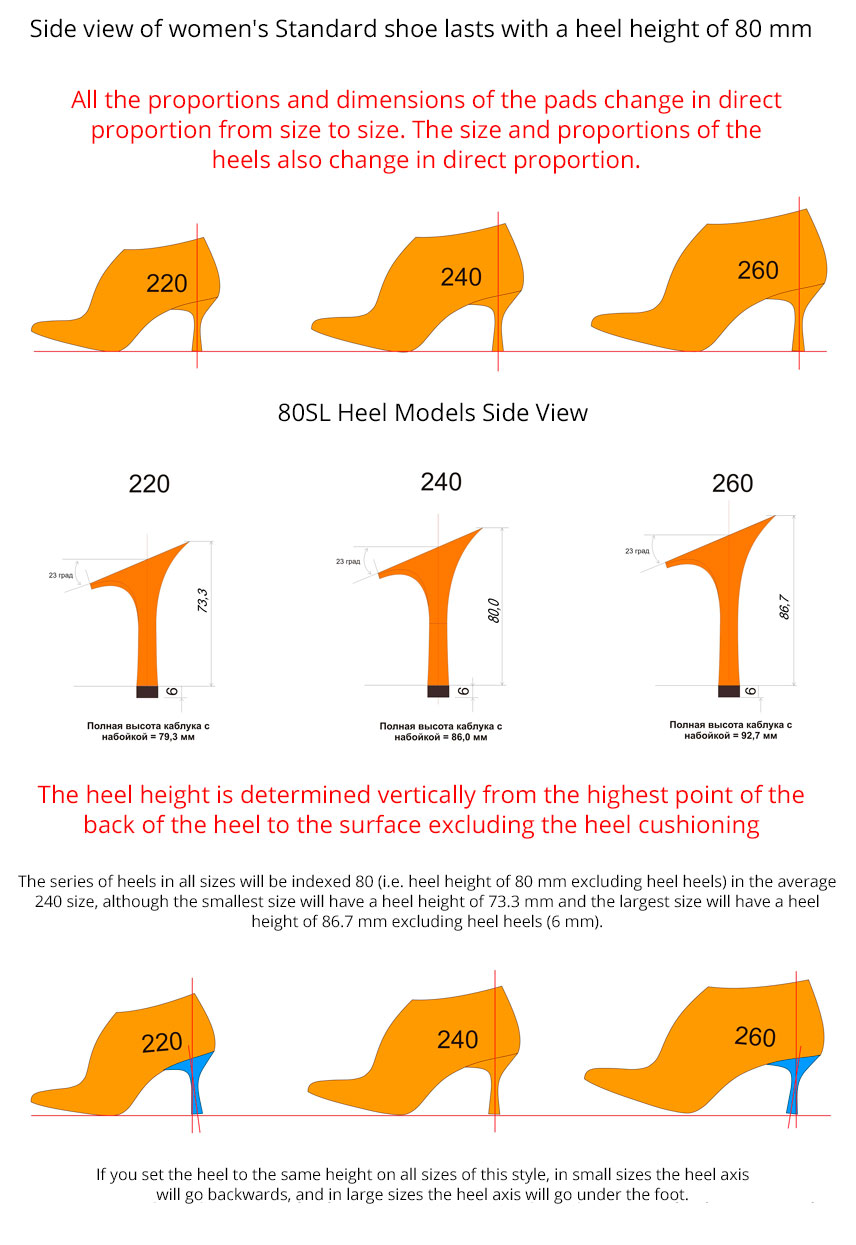Gradation of shoes and heels
The shoe last
The shoe last is a shoe shaping device that is shaped like the human foot during the shoe making process. The shoe last determines the appearance and comfort of the shoe and is the central, most important, complex and closely related to science component of shoe making. The shoe last only partially resembles the human foot in its shape.

Normal grading of lasts and heels
In today's shoe industry, the principle of direct (normal) grading (reproduction) is used in the production of shoe lasts, that is, when the size (number) of the lasts is increased or decreased, their linear dimensions increase or decrease in direct proportion. In the metric size system, the interval between adjacent full sizes is taken to be 10.0 mm, respectively, between half sizes - 5.0 mm. If we take, for example, two adjacent men's half-sizes 270 and 275, then the proportionality coefficient will be K275/270 = 1,02.
Accordingly, all linear and volumetric parameters of the pads will change from size to size in direct proportion, namely:
- If the height of the heel (without heel padding) in the 270 men's size is 20 mm, then in the 275 size it will be 20 mm x 1.02 = 20.37 mm;
- If the width of the heel heel (in the area of the highest bones at 0.68 of the length of the foot) is 70 mm, then the width of the heel in the 275th size will increase to the 270th size by 0.9 mm ((70 x 275/270) x 0.68) = 70.9 mm;
- If the width of the heel heel impression (along the widest part of the heel at 0.18 of the length of the foot) is 45 mm, then in size 275 it will increase by 0.15 mm ((45 x 275/270) x 0.18) = 45.15 mm)
- If the metatarsal girth in the 270 size (along the line of the most exposed bones of the foot at the level of 0.68 of the foot length) is 237 mm, then in the 275 size it will increase by 3 mm ((237 x 275/270) x 0.68) = 240 mm.
For the consumer one of the most important parameters is the change of heel height (especially for high-heeled women's shoes, which will be considered a bit lower).
If we take the extreme sizes in the whole men's size range - from 245 to 315 - the heel heights for these sizes are as follows:
- in size 245: K270/245 = 1.10, respectively, the heel height in size 245 relative to size 270 would be 20/1.10 = 18.15 mm;
- Heel height in size 315: K315/270 = 1.16, correspondingly, the heel height in size 315 relative to size 270 will be 20 х 1.16 = 23.33 mm.
In other words, the difference in heel height between the extreme sizes of the men's size range will be almost 5.2 mm, although formally the whole range will be considered standing on heels of 20 mm.
Women's shoes
All of the above principles are also true for women's shoe lasts, but due to the higher heel height, the changes in the outermost sizes will be greater in ABSOLUTE values. If we consider women's pads with a heel height of, for example, 80 mm in size 240 (37), the outermost sizes of the range - 220 (34.5) and 275 (43) - the heel heights would be as follows:
- in size 220: K240/220 = 1.09, respectively, the heel height in size 220 relative to size 240 would be 80/1.09 = 73.33 mm;
- At size 275: K240/275 = 1.14. Accordingly the heel height in size 275 would be 80x1.14 = 91.67 mm relative to size 240.
I.e., the difference in heel height between the extreme sizes of women's size range will be almost 18.34 mm, although formally the whole range of pads (and shoes, respectively) will be considered standing on 80 mm heels.
Determining heel height
The characteristics, types, definition of parameters and other characteristics of heels are set out in the industry standard "Heels for shoes OST 17-331-87". According to it, the heel height is determined by a straight line from the highest point of the back surface of the heel to the base on which the heel is set, but not taking into account the heel cushion. The standard height of the heelpiece is 5-6 mm. Therefore, the REAL height of the heel with heel cushioning will be 6 mm higher.
Based on this, even in an average women's size, the height of the heel with heel cushioning is 86mm. As for the extreme sizes of the shoe, the largest size (275 metric or 43 mesh) REAL heel height with heel tab will be 97.67mm (!) and the smallest size (220 metric, 34.5 mesh) REAL heel height with heel tab will be 79.33mm, which is important to know when ordering shoes at a certain heel height.

Conclusions
- All parameters of shoe pads and heels grow in direct proportion from size to size.
- The heel heights for the entire size range of one shoe category are determined according to the MEDIUM size range, i.e., for men's shoes the heel height is standardized for size 270 (42), for women's shoes - for size 240 (37), although the actual heel heights in the extreme size range will differ significantly from the average - in the examples cited for low heeled shoes for men, this difference reaches 5.2 mm and in high heeled shoes (here, 80 mm) - up to 18.34 mm.
- When choosing the heel height, do not rely on the marking on the shoe - it corresponds to the MEDIUM size of the shoe, in other sizes the heel height will be either higher or lower than that specified for the medium size. Therefore, if you have a rather big foot size and would like to have shoes with, for example, 80 mm heel height, it is better to order the shoes with 70 mm heel height, which in large size and taking into account the printed heel will have exactly 80 mm height.
For example: your foot size is 260 mm. You would like to have shoes with a heel height of 80 mm in your size. Ordering the shoes with 70mm heel height, in your size the heel height including heel padding will be: (260/240)*70 + 6 = 81.83 mm, which is even slightly higher than your desired heel height.
